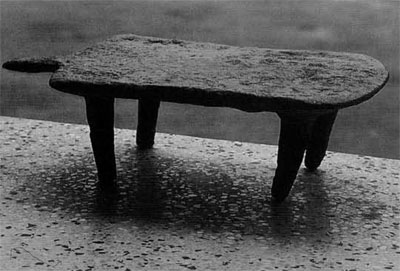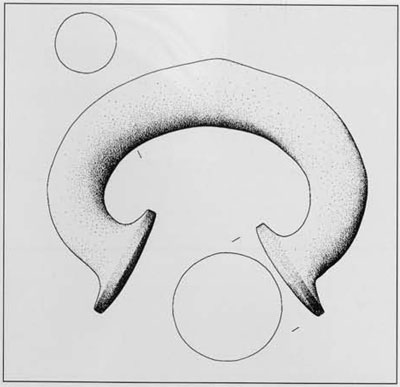In 1870, while tending cattle, two young boys in the village of Ghangaria in central India noticed a long metal object poking out of the ground. Grubbing at the spot revealed many more such pieces, and soon word of the find reached local officials. The discovery of this hoard, with over five hundred copper and silver antiquities weighing some 368 kilograms, added a new and tantalizing chapter to the little-known prehistory of India. Within a few decades the probable great antiquity of these “cherubs,” so called because local inhabitants commonly thought they fell from heaven during thunderstorms, was confirmed. Since then, some 129 large and small hoards consisting of harpoons, flat axes, ingots, lanceheads, and swords have been reported, partly in the Indian Ganges-Yamuna Doab, the land between these two rivers (Figs. 1 and 2). In recent years, large numbers have also come to light a few kilometers to the west and southwest of Delhi. Additional hoards consisting of other kinds of metal artifacts have been found in the fringes and the eastern part of the Chota Nagpur uplands and in the northern hills of Orissa, both of which gradually extend into the plains of West Bengal.
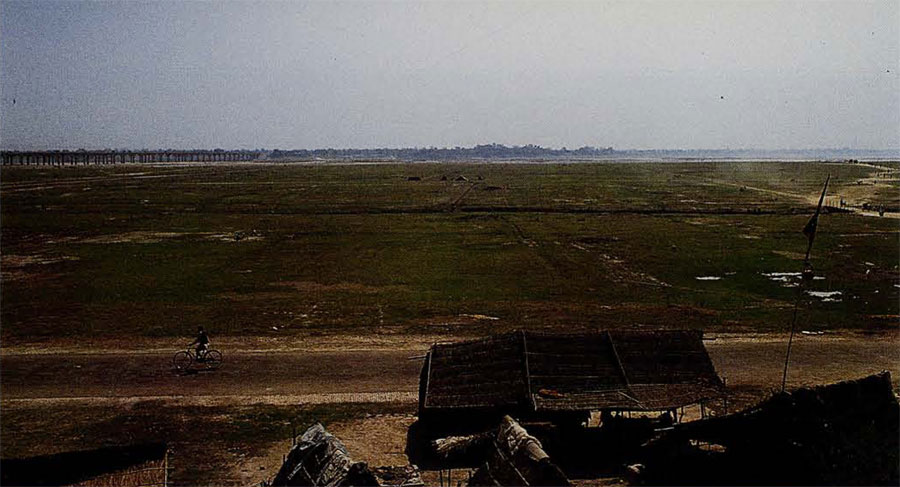
Although these mysterious hoard objects show some general resemblance to more readily dated metal artifacts outside of India from the 2nd millennium ac, unfortunately, none of the 1500 hoard artifacts have come from archaeological excavations that could be dated unequivocally. Over the years more copper weapons and tools have come to light in peasants’ fields, often during agricultural work, or sometimes in local scrap metal markets (Fig. 3). A lack of information on the geomorphology of the findspots hinders a determination of whether these so-called gangaghati were, as their name implies, anciently deposited in the banks of streams or occurred in regular association with other particular features of the landscape.
“Refugees and Displaced Persons”
Who were the creators of the Copper Hoards and why did they bury their metal riches in the ground? In the 1930s Robert von Heine-Geldern, a prominent anthropologist, speculated that the hoards represented the remains of the Aryan-speaking nations that Indian Vedic texts record as having deluged the northern part of the subcontinent during the 2nd millennium B.C. Stuart Piggott, writing after the Second World War, characterized the creators of the Copper Hoards in terms familiar to everyone at that time: “refugees and displaced persons” fleeing the fallen Harappan culture to the west. Somewhat later, the noted archaeologist B. B. Lal suggested still another theory: the makers of the hoards could have been the indigenous Nishâdas, whom the invading Aryans encountered. As described in Vedic texts, their physical features recall those of the present-day Munda, Santhal, and other tribes of the area, which belong to the protoaustraloid population of India.
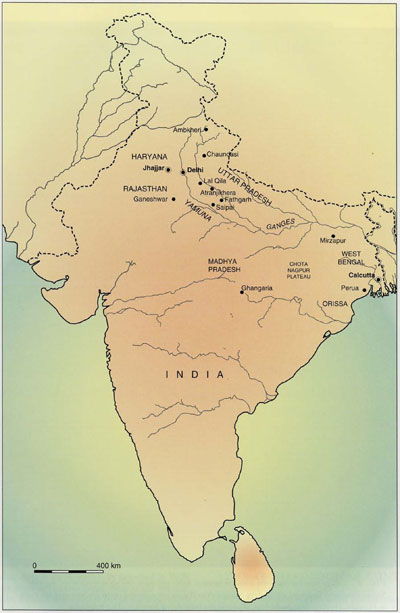
The awesome-looking copper harpoons buried in hoards together with other implements and weapons (Fig. 4) have encouraged some specialists to characterize the hoard folk who inhabited the marshes of the Ganges-Yamuna alluvial plain as hunter-gatherers who hunted muggers (the broad-nosed crocodile of India) and the Gangetic porpoise. The swamps have long since been drained (Fig. 1) and the amphibious animals hunted to extinction, but they did exist into recent history.
Descriptions of the Copper Hoard folk in early archaeological literature reflect a preoccupation with the origins of ancient peoples rather than with their culture and economy. Moreover, such simplistic explanations of function and affiliation of the artifacts are based ultimately on accidentally preserved stray finds, an insubstantial base to support the weighty historical conclusions the objects have inspired. Inasmuch as no extensive settlement or grave has ever yielded Copper Hoard objects, by necessity our conceptions of their creators are based on circumstantial evidence and therefore remain hypothetical in nature.
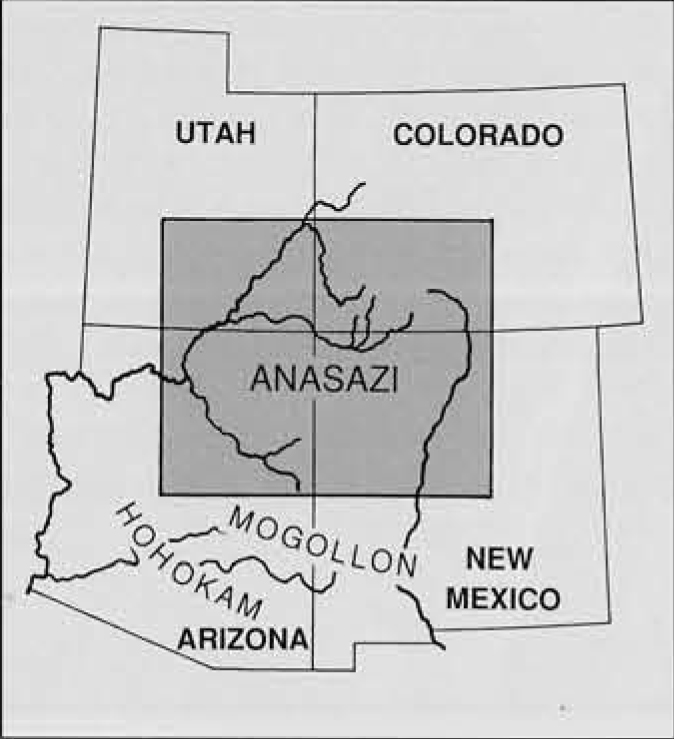
The Archaeological Context
Researchers have devoted considerable effort to uncovering settlement remains associated with the Copper Hoards and linking them to the Vedas (the sacred scriptures of the Hindus). Between 1950 and daub houses), and the bones of Bos indicus (zebu) were found. At Saipai the hoard objects were plundered by the locals. But in 1987 the main excavator there, L. M. Wahal, showed me lumps of clay in which the negative shapes of the copper implements and their patina could be seen. Thus there is no doubt that the hoard objects derived from this site. At “Ambkheri 2” (another OCP site) other objects—a carnelian head, terracotta objects such as miniature cart wheels, animal figurines including a humped bull, a fragmentary terracotta cake with oval impressions, stone saddle querns, and remains of a kiln and hearth—were stratified together with the OCP. Finally, from Atranjikhera organic remains reveal something about the diet of the OCP/Copper Hoard folk. Barley, rice, chickpeas and khesari peas were identified. These few finds, assumed to be contemporary with the hoards, do not present an altogether clear picture of early subsistence, but at least establish the existence of an agrarian economy.
At a time when in other parts of the Old World Bronze Age civilizations were flourishing, the conspicuous paucity of archaeological remains from the huge area east of the well-known Harappan culture is difficult to explain. Most of the early settlements in the former doab swamplands may lie buried beneath the alluvium.
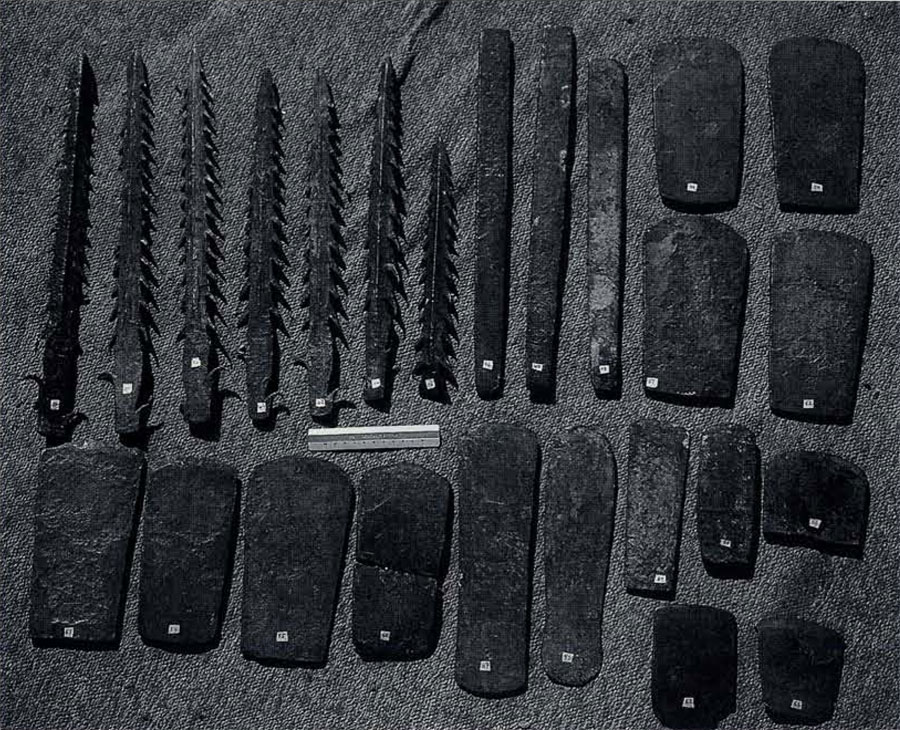
Use-Wear
Copper Hoards previously were known principally from various points in the Ganges-Yamuna Doab and Chota Nagpur uplands. However, a systematic survey initiated in 1980 of all prehistoric Indian metal objects has given us a far more thorough and representative sampling, not only from these two, but from others as well (see Fig. 6). In Haryana, for example, a large state (43,175 sq kin) from which previously no such finds were known, several hundred metal objects have now come to light. There, over the last forty years, prehistoric axes, swords, and harpoons have been found which differ in their form from those hitherto known from the doab. Other metal finds have also been discovered to the south, at the settlement site of Ganeshwar in Rajasthan, which are just as difficult to relate to known artifacts and cultures as the prototypical Copper Hoard artifacts. But in the end, given the lack of excavated associated finds, the metal objects still remain the basis for any discussion of the prehistoric culture of the 2nd millennium BC.
Studies of the use-wear of these metal implements, which had never before been carried out in a sys thematic way, yielded interesting results. While harpoons and other hoard objects are often damaged, closer observation reveals that the damage is nearly always the result of corrosion and the depredations of discoverers, intent on finding precious metal beneath the corroded surface. While a number of the implements have damage that could indeed be ancient, few of the over 1500 Copper Hoard objects have signs of distinctly ancient wear or use. Those that do have such signs include axes with cutting edges worn flat (when viewed face-on) from wear and repeated sharpening, as well as chipped or otherwise damaged mechanically. A thick patina on the damaged parts is an indication of the age of the marring. The axes can be divided into several types on the basis of the proportions of length, width, and sometimes thickness. One of these types has relatively squat proportions. A few examples thereof show use-wear and thus were usable implements.
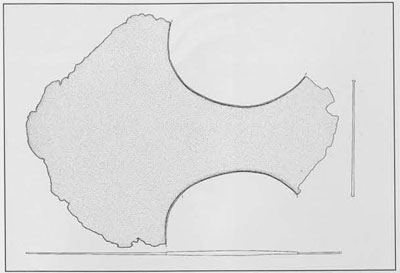
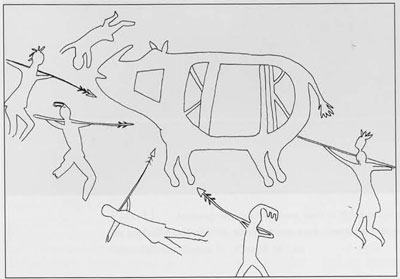
How were the Hoard Objects Used?
A lack of use-wear is not the only reason to question how serviceable the Copper Hoard objects would have been. Some flat axes, which are presumably from hoards and which measure up to 30 centimeters in length, weigh as much as 2 kilograms and have intentionally blunt edges. They would be as difficult to haft as to use. Other hoard axes are made of thin sheet metal. One double-edged axe from Chota Nagpur is paper thin, and another unwieldy example from the same site measures nearly a half meter in length (Fig. 7). Furthermore, most of these large double axes were fashioned with blunt cutting edges. The blade tips of one blunt double axe are so poorly positioned in relation to the “waist” as to allow no room for the handle, if this type of axe was hafted at all.
The question of the utility of the harpoons, which vary considerably in shape, size, and weight (see Fig. 4, upper left), also arises. Most have a tapered shank which enables the head to come free of the attached shaft, once the former has penetrated the game. The more the harpooned animal thrashed and struggled, the more securely the hooks would dig themselves into the flesh. Also characteristic of these harpoons are eyelets or lugs located near the tang, to secure the head to a retrieving line. As is clear from a variety of historical contexts, harpoons are intended for aquatic game. Considering the relatively small size of harpoons used by the Eskimos or pharaonic Egyptians for hunting large aquatic animals, it is difficult to imagine what animals indigenous to the doab would require metal harpoons of up to 44 centimeters in length and 1 kilogram in weight. The Eskimos subdued baleen rorqual whales 20 meters or longer with toggle-headed harpoons usually less than 20 centimeters in length. Even the the largest animals to have inhabited the doab—the muggers, which measure up to 5 meters—could have been taken with far more modest weapons than those preserved. The fact that the hooks of many harpoons curve back toward the shaft instead of projecting outwards also awakens doubts.
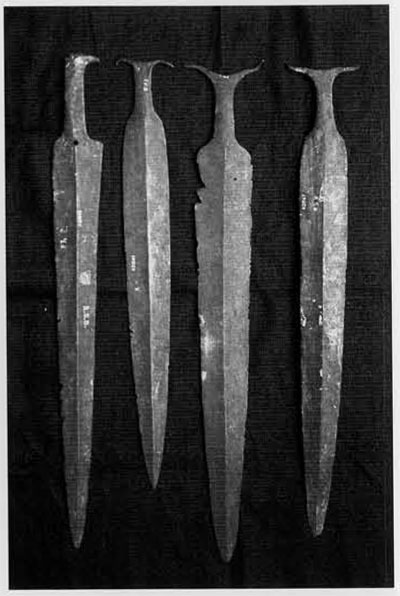
Moreover, the lively and oft-cited (but undatable) cave representation of a rhinoceros hunt from the Mirzapur district (Fig. 8), which in any case lies outside hoard areas, need not necessarily show harpoons in use, but rather barbed spears without retrieving lines. This representation may have nothing whatever to do with the hoards. Since harpoons are limited to the doab and nearby, an area not noted for the occurrence of rhinoceros, their use for hunting this animal seems even less likely. The obviously intentionally awe-inspiring and refined appearance of harpoons, the exaggerated weight and size, all present grounds to doubt a primary utilitarian function.
Swords and lanceheads present even greater problems in that no clearly ancient use-wear or damage is observable and because it is often difficult to confidentially assign specific examples to one or the other of these two artifact categories. While certain swords from the Copper Hoards have stout proportions and may weigh over 2 kilograms (Fig. 9), most are small, slender, and delicate. One example from the site of Chandausi in the doab, for example, weighs a scant 295 grams. Presumably the armor worn in combat at this time was light or non-existent, which would condition the size and weight of the associated weapons. Even so, it is more plausible to envision the lightweight swords as ceremonial, cultic, or ritual objects rather than as combat arms.
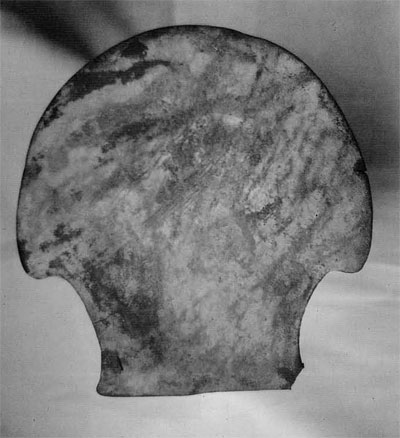
So-called lanceheads are distinguished from swords in that they have a tang too short to serve as a sword handgrip. Often a hook is split off the tang, which seems to have functioned to fix the point to the shaft. The short tangs of examples weighing nearly 2 kilograms and measuring some 70 centimeters in length are the weak point of the construction and this flaw may be taken as grounds to question their functionality. The modern-day Rengma, Angami, and Lhota Naga tribesmen in the extreme northeast of India use various and outsized iron spearheads for “ceremonial” purposes and as status symbols—providing a modern analogy for the function of our lanceheads. Their construction and appearance, however, is poorly documented. Naga lances are also known whose blades measure up to 20 centimeters; the entire length of the mostly iron weapon may reach 2 meters. In opposition to the principally ceremonial use for Naga weapons described above, J. M. Kenoyer has witnessed them used for dancing and hunting, and as status symbols. These heavy thrusting lances are also serviceable against wild boar, lions, and tribal enemies. An even more interesting modern parallel for the use of barbed spearheads is known from the eastern Angami warriors. The shanks of their ceremonial spears are adorned with a series of purely ornamental barbs cut from the solid metal. The barbs are regular and vary according to the martial achievements of the owner, but for reasons unknown very rarely exceed five.
About 140 copper artifacts derived from the copper-rich eastern Chota Nagpur region appear at first glance to be axe heads but bear no real resemblance to known Indian prehistoric axe types (Fig. 10). They are often heavy and large, somewhat plano-convex, have a grainy surface, and almost invariably show dull and rounded cutting edges. An interpretation for these often irregularly shaped objects as ingots can be paralleled in other cultures, particularly in western Europe and Latin America. But at the same time the question arises of why only such axe-ingots and not axes themselves occur in Chota Nagpur: only four prehistoric axes are known from the region. Like these axe-ingots, the over 50 so-called bar celt-ingots and fragments thereof show no traces of use-wear and served no obvious function. There is no good reason to see them as the points of primitive ploughs or digging sticks, as some researchers have speculated. Dibble sticks, such as those used by indigenous tribal peoples to make planting holes, are pointed, relatively light, and circular in section. The long and heavy bar celt-ingots, with their dull chisel-like edges and (in cross section) bell-shaped shafts, are poorly suited for hand digging.
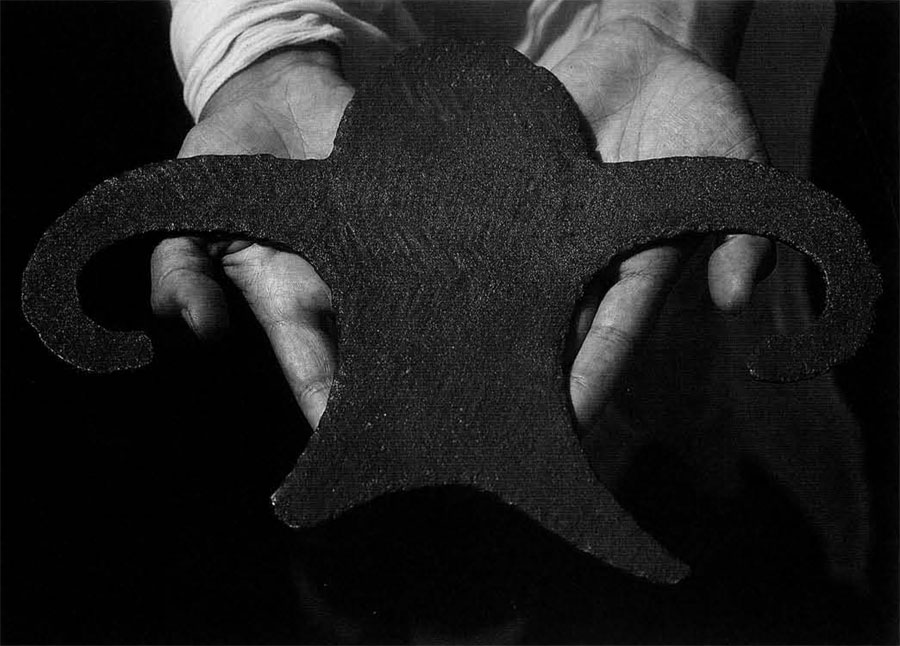
Hoard Items as Cult Objects
There are, however, hoard objects for which a cultic significance is certain, including various flat anthropomorphic figures (Fig. 11). Some experts have identified these as weapons, but they are impractical for this purpose and usually too heavy, some weighing over 6 kilograms. A cultic interpretation for them, for the sheet-silver bull’s heads and discs from a hoard at Ghangaria, and for a cult stand from Chota Nagpur (Fig. 12), is practically the only one available. This explanation is also attractive for a large copper ring, also from Chota Nagpur (Fig. 13). Too large for human adornment, it may have been intended for a supernatural user.
On the strength of what is known, it is possible that the various hoard objects may have had more than a single function. But in light of observations on use-wear and their shape (form follows function), it seems more reasonable to identify at least some of the hoards as votive depositions of metal riches, sometimes in ingot-like form, in preference to other explanations, such as their being the stores of casters or itinerant traders, grave goods, or other kinds of caches. Too, other possible explanations remain open, such as potlatch-like phenomena, whereby for various reasons quantities of pre pious objects are discarded or destroyed.
It is curious that metal implements belonging to the usual inventory of ancient or modern Indian villages, such as knives, digging tools, and arrowheads, are absent in the Copper Hoards. They and other cultural goods may have been made of wood or bamboo, a distressing thought, for it means that we possess practically no implements of daily life for the inhabitants of 2nd millennium northeastern India. Hoard objects often show excellent workmanship and are pleasing in form. But technically speaking their metallurgy is simple, since they are fashioned of non-alloyed copper. Paradoxically, the far less attractive artifacts of the neighboring Harappa culture, probably some centuries prior to this, show a mastery of copper-tin alloying. Thus they are technically superior to the hoard objects.
